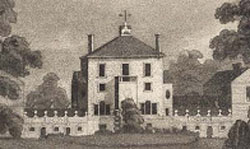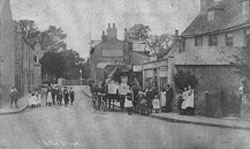Whitton
Kneller Hall was replaced twice, Whitton Park is now lost and many smaller buildings demolished

Until the 1930s there were very few houses in Whitton. The population in 1664 has been estimated at 120 and even by 1901 there were still fewer than 220 households. There have, however, been a number of large houses over the last four centuries which are all now lost or rebuilt.
Kneller Hall is the third house to occupy the site. The first was built by Edmund Cooke in 1632. Sir Godfrey Kneller replaced this with his own by 1711. In 1847 the house was bought as a training college and was largely rebuilt in 1850. In 1856 the War Department took over the building and it reopened in 1857 as the Royal Military School of Music. There was another large house opposite Kneller Hall, built in 1687 by Lord John Belassis of Worlaby. It was demolished in 1778 after it had been bought by the owner of Kneller Hall, to improve his view. In 1894 the property was divided up and the former walled kitchen garden was used by the War Department as an enclosure for the married-quarters.
In 1609 John Suckling Jr was born in an existing large house and in 1622 his father, Sir John Suckling, built a second and larger house. The house had fallen into decay by 1730 and the land was leased out as farmland. What remained of it probably comprised Warren Farm, later The Warren, which disappeared when Warren Road was cut through in 1931.

In 1625 a large house was built by Henry Saunders. This was acquired in 1722 by Archibald Campbell, Lord Ilay and 3rd Duke of Argyll. He first built a greenhouse with upper floor accommodation in 1725 and next a Palladian Villa in 1737.

In 1772 the other side of the greenhouse was converted into a mansion (Whitton Park) and the estate divided. The Palladian Villa was demolished in 1847. Whitton Park, was demolished in 1910 and by 1935 all the land was developed with housing.

Another large house, built for the 3rd Duke of Argyll's mistress, in the 1730s, was known as Whitton Dean. It was demolished in 1847 and so in 1914 became Murray Park: “A people's pleasure ground”.

A number of smaller houses and cottages have also been lost. One example is in Percy Road, running between The Nelson and the railway, which became the High Street in 1938. The west side of the High Street is made up of distinct blocks of piecemeal development, each ghosting the footprint of what went before.
Rows of cottages, long since demolished, such as Hope and Anchor Cottages, Hume Cottages, Notts Cottages, Daisy Cottages and Woodbine Cottages thus still leave a small mark on the modern world.



